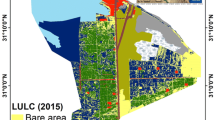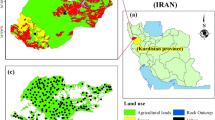Abstract
An uneasy population increase requires expansion of the agricultural area. Egypt has a strategic direction in expanding agricultural areas, which highlights the objective of the research that is to assess soil fertility through its geographical assessment and remote sensing. The examination region of this investigation is situated in north region of west desert, about 55 km, west of Cairo, Egypt. A semi-detail survey was carried out using remote sensing (RS) and geographic information systems (GIS) for the study. The results found the high suitable areas (S1) for field crops; barley and wheat were about 54.7% for each of the total area, while for corn and beans were about 44.9% for each of the total area, while S1 areas for vegetable crops; tomato, eggplant, and melon were 67.8, 71.2, and 53.2% of the total area, respectively, while S2 for pepper–zucchini was about 65.4 and 49.7% of the total area, respectively. But for fruit trees, S1 is for pears (60.3%), pomegranates (50.9%), and palms (80.2%) while S2 for olives (30.3%), Figs. (30.3%), almonds (10.4%), vines (19.7%), and peaches (20.5%). To reduce water losses is by improving the means of delivery and raising the efficiency of irrigation, by evaluating the appropriate situation of the irrigation system for soil quality in the study area, and by choosing the appropriate methods of irrigation in the region to raise efficiency in rationalizing consumption and reducing losses. Drip and sprinkle irrigation suitability for the entire area are moderate to high, where soil texture factor is limiting drip irrigation method while wind speed and soil texture factors are limiting sprinkle irrigation in the area.









Similar content being viewed by others
References
AbdelRahman MAE, Tahoun SA, Abdel Bary EA and Arafat SM (2008) Detecting land degradation processes using geo statistical approach in Port Said, Egypt. Zagazig J Agric Res 35(6):1361–1379
AbdelRahman MAE (2014) Assessment of land degradation and land use planning by using remote sensing and GIS techniques in Chamarajanagar District, Karnataka (Ph.D. thesis) submitted to UAS, Bangalore University, India
AbdelRahman MAE, Natarajan A, Hegde R (2016a) Assessment of land suitability and capability by integrating remote sensing and GIS for agriculture in Chamarajanagar district, Karnataka, India. Egypt J Remote Sens Space Sci. https://doi.org/10.1016/j.ejrs.2016.02.001
AbdelRahman MAE, Natarajan A, Srinivasamurty CA, Hegde R (2016b) Estimating soil fertility status in physically degraded land using GIS and remote sensing techniques in Chamarajanagar district Karnataka India. Egypt J Remote Sens Space Sci. https://doi.org/10.1016/j.ejrs.2015.12.002
AbdelRahman MAE, Tahoun S (2019) GIS model-builder based on comprehensive geostatistical approach to assess soil quality. Remote Sens Appl Soc Environ 13:204–2014. https://doi.org/10.1016/j.rsase.2018.10.012
AbdelRahman MAE, Shalaby A, Essa EF (2018a) Quantitative land evaluation based on fuzzy-multi-criteria spatial model for sustainable land-use planning. Model Earth Syst Environ 4:1341–1353. https://doi.org/10.1007/s40808-018-0478-1
AbdelRahman MAE, Natarajan A, Rajendra H, Prakash SS (2018b) Assessment of land degradation using comprehensive geostatistical approach and remote sensing data in GIS-model builder. J Remote Sens Space Sci Egypt. https://doi.org/10.1016/j.ejrs.2018.03.002
AbdelRahman MAE, Shalaby A, Mohamed ES (2018c) Comparison of two soil quality indices using two methods based on geographic information system. J Remote Sens Space Sci Egypt. https://doi.org/10.1016/j.ejrs.2018.03.001
AbdelRahman MAE, Natarajan A, Srinivasamurthy CA, Hegde R, Prakash SS (2018d) Assessment of soil quality by using remote sensing and GIS techniques; a case study, Chamrajanagar District, Karnataka, India. Acta Sci Agric 2(1):05–12
AbdelRahman MAE, Metwaly MM, Shalaby A (2019) Quantitative assessment of soil saline degradation using remote sensing indices in Siwa Oasis. Remote Sens Appl Soc Environ 13:53–60. https://doi.org/10.1016/j.rsase.2018.10.004
AbdelRahman MAE, Arafat SM (2020) An approach of agricultural courses for soil conservation based on crop soil suitability using geomatics. Earth Syst Environ 4:273–285. https://doi.org/10.1007/s41748-020-00145-x
AbdelRahman MAE, Zakarya YM, Metwaly MM, Koubouris G (2021) Deciphering soil spatial variability through geostatistics and interpolation techniques. Sustainability 13:194. https://doi.org/10.3390/su13010194
Abuzaid SA, Abdellatif DA, Fadl ME (2020) Modeling soil quality in Dakahlia Governorate, Egypt using GIS techniques The Egyptian Journal of Remote Sensing and Space. Science. https://doi.org/10.1016/j.ejrs.2020.01.003
Abuzaid AS, Fadl ME (2018) Mapping potential risks of long-term wastewater irrigation in alluvial soils. Egypt Arab J Geosci 11:433. https://doi.org/10.1007/s12517-018-3780-3
AdelRahman MAE (2009) Quantification of land degradation indicators using remote sensing and GIS techniques. M. Sc. Thesis submitted to Zagazig University, Egypt
Ali RR, Abd El-Kader AA, Essa EF, AbdelRahman MAE (2019) Application of remote sensing to determine spatial changes in soil properties and wheat productivity under salinity stress. Plant Archives 19(1):616–621
Andrews SS, Flora CB, Mitchell JP, Karlen DL (2003) Growers’ perceptions and acceptance of soil quality indices. Geoderma 114:187–213
Andrews SS, Karlen DL, Cambardella CA (2004) The soil management assessment framework: a quantitative soil quality evaluation method. Soil Sci Soc Am J 68:1945–1962
Berterretche M, Hudak AT, Cohen WB, Maiersperger TK, Gower ST, Dungan J (2005) Comparison of regression and geostatistical methods for mapping Leaf Area Index (LAI) with Landsat ETM+ data over a boreal forest. Remote Sens Environ 96(1):49–61
Bibby J, Douglas H, Thomasson A, Robertson J (1991) Land capability classification for agriculture. Macaulay Land Use Research Institute, Aberdeen
Desoukey SF, El-Nahas SE, Sabh AZ, Taha ZK, El-Shabrawi HM (2020a) Antimicrobial effect of Asparagus officinalis L. extracts. Plant Archives 20(2):9253–9264
Desoukey SF, Taha ZK, El-Shabrawi HM, Sabh AZ (2020b) Impact of zinc oxide nanoparticles on Asparagus officinalis plant. Plant Archives 20(.2):9323–9338
Desoukey SF, Taha ZK, El-Shabrawi HM, Desoukey AF, Sabh AZ (2019) Biological effects of zinc oxide nanoparticles on in vitro Asparagus officinalis L. plant. Plant Archives 19(2):2262–2268
Economic and Social Research Institute. (2001). ArcGIS geostatistical analyst: statistical tools for data exploration, modeling, and advanced surface generation. Retrieved 20.7.2011, from http://www.esri.com/library/whitepapers/pdfs/geostat.pdf
El-Zeiny AM, Effat HA (2017) Environmental monitoring of spatiotemporal change in land use/land cover and its impact on land surface temperature in El-Fayoum governorate. Egypt Remote Sensing Applications: Society and Environment 8:266–277. https://doi.org/10.1016/j.rsase.2017.10.003
El-Zeiny AM, Effat HA (2019) Environmental analysis of soil characteristics in El-Fayoum Governorate using geomatics approach. Environ Monit Assess 191:463. https://doi.org/10.1007/s10661-019-7587-9
FAO (2007) Land evaluation: towards a revised framework. Land and Water Discussion Paper 6. Rome, IT: Food and Agriculture Organization of the United Nations
Farg E, Arafat SM, El-Wahed MA, El-Gindy AM (2012) Estimation of evapotranspiration ETc and crop coefficient Kc of wheat, in south Nile Delta of Egypt using integrated FAO-56 approach and remote sensing data. The Egyptian Journal of Remote Sensing and Space Science 15(1):83–89
Farg E, Arafat S, El-Wahed MA, El-Gindy A (2017) Evaluation of water distribution under pivot irrigation systems using remote sensing imagery in eastern Nile delta. The Egyptian Journal of Remote Sensing and Space Science 20:S13–S19
Goodman N (1963) Statistical analysis based on a certain multivariate complex Gaussian distribution (an introduction). Ann Math Stat 34(1):152–177
Hadji R., Achour Y., Hamed Y. (2018) Using GIS and RS for slope movement susceptibility mapping: comparing AHP, LI and LR methods for the Oued Mellah Basin, NE Algeria. In: Kallel A., Ksibi M., Ben Dhia H., Khélifi N. (eds) Recent Advances in Environmental Science from the Euro-Mediterranean and Surrounding Regions. EMCEI 2017. Advances in Science, Technology & Innovation (IEREK Interdisciplinary Series for Sustainable Development). Springer, Cham.https://doi.org/10.1007/978-3-319-70548-4_536
Hanan AEAH, Rehab HH (2018) Effect of magnetic water and ascorbic acid on the productivity of Lavandula pubescens Decne and nutrients availability in soil under Siwa Oasis conditions. Middle East J Agric Res 7(3):1072–1089
Hassan AN, Kenawy MA, Kamal H, Abdel Sattar AA, Sowilem MM (2003) GIS-based prediction of malaria risk in Egypt. East Mediterr Health J 9(4):548–558
Hellal F, El-Sayed S, Taha ZK, Desouky SF, Abdelly C (2020) Biochemical changes of Mediterranean barley as affected by drought stress. Plant Archives 20(2):3717–3724
Hengl T, Heuvelink GBM, Rossiter DG (2007) About regression-kriging: from equations to case studies. Comput Geosci 33(10):1301–1315. https://doi.org/10.1016/j.cageo.2007.05.001
Hengl T, Heuvelink GBM, Stein A (2004) A generic framework for spatial prediction of soil variables based on regression-kriging. Geoderma 120(1–2):75–93. https://doi.org/10.1016/j.geoderma.2003.08.018
Lark RM, Ferguson RB (2004) Mapping risk of soil nutrient deficiency or excess by disjunctive and indicator kriging. Geoderma 118(1–2):39–53 (101)
Lindsay WL, Norvell WA (1978) Development of a DTPA soil test for zinc, iron, manganese, and copper. Soil Sci Soc Am J 42:421–428
Matheron G (1965). Les variables régionalisées et leur estimation: Centre de Géosciences, Paris. (in French)
Mukashema, A. (2007). Mapping and modelling landscape-based soil fertility change in relation to human induction. Unpublished MSc thesis. School of Natural Resource Management, ITC.
Park SJ, Vlek PLG (2002) Environmental correlation of three-dimensional soil spatial variability: a comparison of three adaptive techniques. Geoderma 109(1–2):117–140. https://doi.org/10.1016/s0016-7061(02)00146-5
Parker FW, Nelson WL, Winters E, Miles JE (1951) The broad interpretation and application of soil test summaries. Agron J 43(3):103–112
Rees D (1995) A land capability study of the Cassilis Valley, Swifts Creek. Centre for land protection research. Technical report No.27
Rehab HH (2018) Evaluation of nitrogen sources and polymer coated fertilizers on wheat yield in sandy soil. Asian J. Soil Sci Plant Nutr 3(3):1–12
Rehab HH, Eissa D, Abou-Shady A, Abdelmottaleb O (2016) Effect of biochar addition on soil properties and carrot productivity Grown in polluted soils. Egyptian J Desert Res 66(2):327–350
Rehab HH, Yousra HK, Eissa D (2018) Using nanotechnology for enhancing phosphorus fertilizer use efficiency in peanut bean grown in sandy soils. J adv pharmacy education and Res 8(3):59–67
Saxton KE et al (1986) Estimating generalized soil-water characteristics from texture. Soil Sci Soc Amer J 50(4):1031–1036
Soil Conservation Service (1992) Soil conservation service. Washington, DC, pp 60–73
Soil Conservation Service, Washington, DC, Soil Survey Staff (1959) Land capability subclass. Soils Memorandum SCS-30. Soil Conservation Service, Washington, DC
Soil Conservation Service (1963) Know the capability of your land. USDA-NRCS, Washington, DC, pp 1–25
Soil Survey Division Staff (1993) Soil survey manual. Soil Conservation Service. U.S. Department of Agriculture Handbook 18
Soil Survey Staff (1958) Land capability classification. Soils memorandum SCS–22. Soil Conservation Service, Washington, DC
United States Department of Agriculture (1973) Soil conservation service, land capability classification, agriculture handbook No. 210.
U.S. Department of Agriculture, Natural Resources Conservation Service, National Soil Survey Center (USDA–NRCS–NSSC). (2014) Soil Survey Field and Laboratory Methods Manual Soil Survey Investigations Report No. 51Version 2.
U.S. Department of Agriculture, Soil Conservation Service (USDA–SCS). (1971). Handbook of soil survey investigations field procedures. USDA–SCS. GPO, Washington, DC
US SCS (1992) Soil conservation service US. Soil Conservation Service, Washington, DC, pp 60–73
Verheye WH, Koohafkan AP, Nachtergaele F (2009) The FAO guidelines for land evaluation. In: Verheye WH (ed) Encyclopedia of land use, land cover and soil sciences: Land evaluation, Vol. 2: Encyclopedia of life support systems. EOLSS Publishers, Oxford, pp 78–100
Zinck JA, Valenzuala CR (1990) Soil geographic database: structure and application examples, ITC. J.1990, vol 3. ITC, Enschade
Author information
Authors and Affiliations
Corresponding author
Rights and permissions
About this article
Cite this article
AbdelRahman, M.A.E., Hegab, R.H. & Yossif, T.M.H. Soil fertility assessment for optimal agricultural use using remote sensing and GIS technologies. Appl Geomat 13, 605–618 (2021). https://doi.org/10.1007/s12518-021-00376-1
Received:
Accepted:
Published:
Issue Date:
DOI: https://doi.org/10.1007/s12518-021-00376-1




